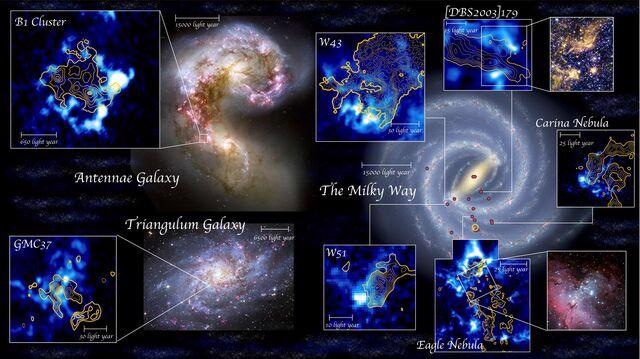May 10 2021
Stars develop by the gravitational contraction of clouds of gas in space and can possess several masses. Enormous stars, along with various other stars, might develop a large star cluster (a group of over 10,000 stars).
 Demonstration of typical colliding molecular clouds (represented by blue color and yellow contours) forming star clusters discovered by radio observations. Positions of the cluster-forming colliding clouds reported in the present special issue are denoted by red dots plotted on the picture of the Milky Way Galaxy on the right (the circle denotes the position of the Sun). Images of the Antennae Galaxies and the Triangulum Galaxy are shown on the left. The inset optical images show the Eagle Nebula and [DBS2003]179, where shining nebulae and newly born star clusters can be seen. Image Credit: Nagoya University, National Astronomical Observatory of Japan, NASA, JPL-Caltech, R. Hurt (SSC/Caltech), Robert Gendler, Subaru Telescope, ESA, The Hubble Heritage Team (STScI/AURA), Hubble Collaboration, and 2MASS.
Demonstration of typical colliding molecular clouds (represented by blue color and yellow contours) forming star clusters discovered by radio observations. Positions of the cluster-forming colliding clouds reported in the present special issue are denoted by red dots plotted on the picture of the Milky Way Galaxy on the right (the circle denotes the position of the Sun). Images of the Antennae Galaxies and the Triangulum Galaxy are shown on the left. The inset optical images show the Eagle Nebula and [DBS2003]179, where shining nebulae and newly born star clusters can be seen. Image Credit: Nagoya University, National Astronomical Observatory of Japan, NASA, JPL-Caltech, R. Hurt (SSC/Caltech), Robert Gendler, Subaru Telescope, ESA, The Hubble Heritage Team (STScI/AURA), Hubble Collaboration, and 2MASS.
The development of such a star cluster needs the quick packing of huge amounts of gas and other materials into a compact space. However, the mechanism by which this takes place is yet to be explained.
Under the guidance of Associate Professor Kengo Tachihara and Emeritus Professor Yasuo Fukui of Nagoya University, a research group concentrated on a hypothesis in which several gas clouds tend to clash, thereby enabling them to get collected in an efficient manner and thus developing into a star cluster.
To confirm this hypothesis, the research group, together with scientists from Osaka Prefecture University and the National Astronomical Observatory of Japan, carried out observational studies of a huge amount of data acquired by research performed over a decade, including theoretical studies of numerical simulations with the data.
They discovered that collisions of gas clouds hovering in space do, indeed, trigger the origin of a star cluster.
The researchers noticed that several collisions of gas clouds in the Milky Way Galaxy and also in other galaxies indicate that such collisions are a global phenomenon.
From this point of view, there is a high chance that the Milky Way Galaxy collided with other galaxies shortly following its birth, which led the gas clouds in the galaxies to collide often, leading to the development of several globular clusters (groups of over one million stars).
The study results have contributed to better insights into the formation of huge stars and the origin of globular clusters.
The study includes a collection of 20 original papers depending on detailed verifications of separate astronomical bodies, as well as a review paper outlining the latest insights into star formation by collisions of gas clouds.
Journal Reference:
Fukui, Y., et al. (2021) Cloud–cloud collisions and triggered star formation. Publications of the Astronomical Society of Japan. doi.org/10.1093/pasj/psaa103.